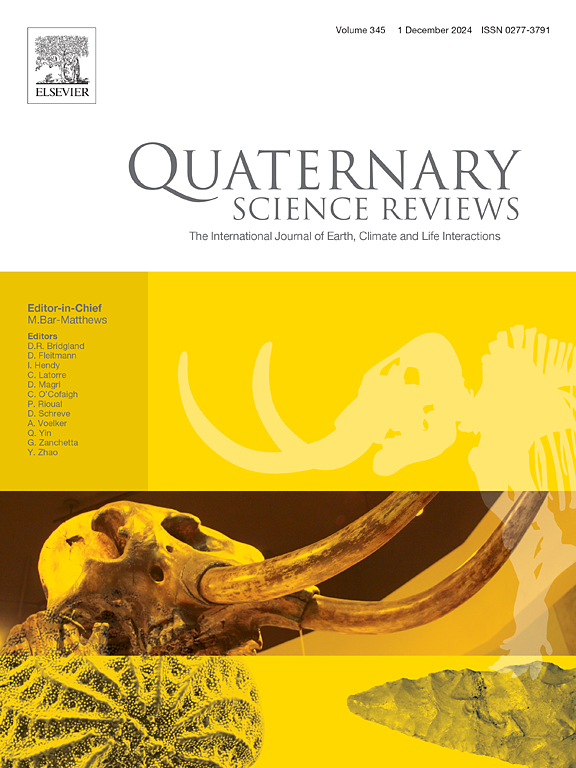南极洲西部坎布冰流接地带的近期沉积学及对冰架范围的影响
IF 3.2
1区 地球科学
Q1 GEOGRAPHY, PHYSICAL
引用次数: 0
摘要
浮冰下堆积的沉积物记录了极地地区冰层的动态变化,而这些地区很少进行现场观测。2019年,在罗斯冰架上距坎布冰流(KIS)接地线(南纬82.7841°,西经155.2626°)5公里处的一个590米厚的区域融化了一个洞,以进入海底。遥控潜水器(ROV,Icefin)拍摄的图像显示,洋流产生的波纹可能是由与接地线(GL)平行的潮汐流形成的。观测到的海流速度为 0.15 米/秒-1,表明这些海床地貌可能是遗迹。与 KIS 原水流方向平行的 dm 尺度的较大 "沟壑 "可能与过去的接地线过程有关。从海底采集的 0.49 米长的重力岩芯含有弱分层的二迭石。沉积物基质由不同的第三纪生物硅石(主要是硅藻)和假火山物质的混合物组成。沉积物的εNd值为7∼7,与WAIS的衍生物一致,U-Pb年龄分布和模拟的全新世晚期冰流也是如此。斜坡热解14C分析表明,所有馏分都是30 ka或14C死馏分。相比之下,210Pb-210 的活性为 30 Bq Kg-1,表明沉积时间在过去 120 年内。这些特征的结合表明,随着 GL 的后退,沉积物较多的基底碎屑层融化,形成了快速的雨后沉积,随后洋流进行了一些再加工,几乎没有现代堆积。虽然第三纪硅藻非常丰富,但没有明确的第四纪晚期硅藻,我们推测这对罗斯冰架稳定性的影响。[239 wds]本文章由计算机程序翻译,如有差异,请以英文原文为准。
Recent sedimentology at the grounding zone of the Kamb Ice stream, West Antarctica and implications for ice shelf extent
Sediment accumulating beneath floating ice contains a record of ice dynamics in polar regions where in situ observations are rare. In 2019 a hole was melted through a 590m-thick region of the Ross Ice Shelf ∼5 km seawards of the Kamb Ice Stream (KIS) grounding line (82.7841°S, 155.2626°W) to access the seafloor. Imagery from a remotely operated vehicle (ROV, Icefin) shows ocean current-generated ripples likely formed by tidal flow parallel to the grounding line (GL). Observed current speeds <0.15 m s−1 suggest these bedforms may be relict. Larger, dm-scale, ‘furrows’ parallel to the former direction of KIS flow may relate to past grounding line processes. A 0.49 m-long gravity core collected from the seafloor contains weakly stratified diamicton. The sediment matrix comprises variable mixtures of reworked Tertiary biogenic silica, predominantly diatoms, and arkose material. Sediment εNd values of ∼7 are consistent with derivation from the WAIS, as is the U-Pb age distribution and modelled late Holocene ice flows. Ramped pyrolysis 14C analysis shows all fractions are either >30 ka or 14C dead. By contrast, 210Pb-210 activity of >30 Bq Kg−1 indicates deposition within the last 120 years. The combination of features suggests rapid rainout deposition from melting of a sediment-laden basal debris layer as the GL retreated, followed by some reworking by ocean currents and little modern accumulation. Although Tertiary diatoms are abundant, unambiguously Late Quaternary forms are absent and we speculate on the implications for Ross Ice Shelf stability. [239 wds]
求助全文
通过发布文献求助,成功后即可免费获取论文全文。
去求助
来源期刊

Quaternary Science Reviews
地学-地球科学综合
CiteScore
7.50
自引率
15.00%
发文量
388
审稿时长
3 months
期刊介绍:
Quaternary Science Reviews caters for all aspects of Quaternary science, and includes, for example, geology, geomorphology, geography, archaeology, soil science, palaeobotany, palaeontology, palaeoclimatology and the full range of applicable dating methods. The dividing line between what constitutes the review paper and one which contains new original data is not easy to establish, so QSR also publishes papers with new data especially if these perform a review function. All the Quaternary sciences are changing rapidly and subject to re-evaluation as the pace of discovery quickens; thus the diverse but comprehensive role of Quaternary Science Reviews keeps readers abreast of the wider issues relating to new developments in the field.
 求助内容:
求助内容: 应助结果提醒方式:
应助结果提醒方式:


